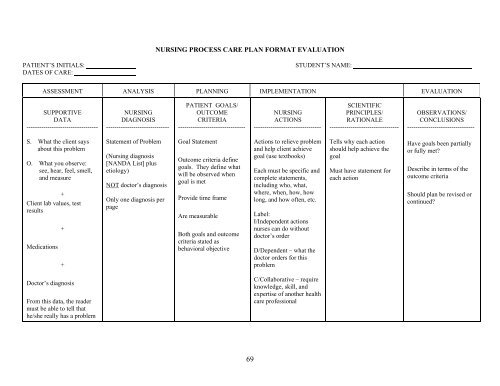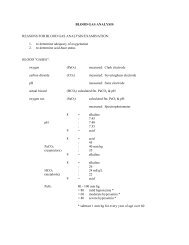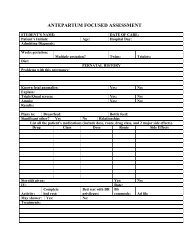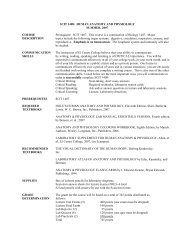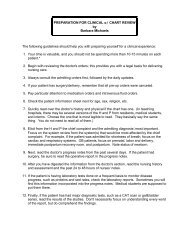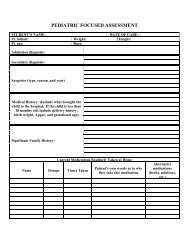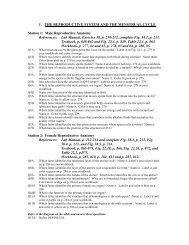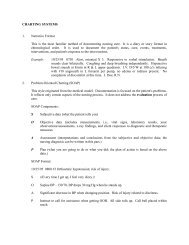Nursing Care Plan Format Explanation
Nursing Care Plan Format Explanation
Nursing Care Plan Format Explanation
Create successful ePaper yourself
Turn your PDF publications into a flip-book with our unique Google optimized e-Paper software.
NURSING PROCESS CARE PLAN FORMAT EVALUATION<br />
PATIENT’S INITIALS: STUDENT’S NAME:<br />
DATES OF CARE:<br />
ASSESSMENT ANALYSIS PLANNING IMPLEMENTATION EVALUATION<br />
SUPPORTIVE<br />
DATA<br />
----------------------------------<br />
NURSING<br />
DIAGNOSIS<br />
------------------------------<br />
PATIENT GOALS/<br />
OUTCOME<br />
CRITERIA<br />
--------------------------------<br />
NURSING<br />
ACTIONS<br />
--------------------------------<br />
SCIENTIFIC<br />
PRINCIPLES/<br />
RATIONALE<br />
---------------------------------<br />
OBSERVATIONS/<br />
CONCLUSIONS<br />
--------------------------------<br />
S. What the client says<br />
about this problem<br />
O. What you observe:<br />
see, hear, feel, smell,<br />
and measure<br />
+<br />
Client lab values, test<br />
results<br />
Medications<br />
+<br />
+<br />
Statement of Problem<br />
(<strong>Nursing</strong> diagnosis<br />
[NANDA List] plus<br />
etiology)<br />
NOT doctor’s diagnosis<br />
Only one diagnosis per<br />
page<br />
Goal Statement<br />
Outcome criteria define<br />
goals. They define what<br />
will be observed when<br />
goal is met<br />
Provide time frame<br />
Are measurable<br />
Both goals and outcome<br />
criteria stated as<br />
behavioral objective<br />
Actions to relieve problem<br />
and help client achieve<br />
goal (use textbooks)<br />
Each must be specific and<br />
complete statements,<br />
including who, what,<br />
where, when, how, how<br />
long, and how often, etc.<br />
Label:<br />
I/Independent actions<br />
nurses can do without<br />
doctor’s order<br />
D/Dependent – what the<br />
doctor orders for this<br />
problem<br />
Tells why each action<br />
should help achieve the<br />
goal<br />
Must have statement for<br />
each action<br />
Have goals been partially<br />
or fully met<br />
Describe in terms of the<br />
outcome criteria<br />
Should plan be revised or<br />
continued<br />
Doctor’s diagnosis<br />
From this data, the reader<br />
must be able to tell that<br />
he/she really has a problem<br />
C/Collaborative – require<br />
knowledge, skill, and<br />
expertise of another health<br />
care professional<br />
69
NURSING PROCESS CARE PLAN FORMAT<br />
PATIENT’S INITIALS: STUDENT’S NAME:<br />
DATES OF CARE:<br />
ASSESSMENT ANALYSIS PLANNING IMPLEMENTATION EVALUATION<br />
SUPPORTIVE<br />
DATA<br />
NURSING<br />
DIAGNOSIS<br />
CLIENT GOALS/<br />
OUTCOME<br />
CRITERIA<br />
NURSING<br />
ACTIONS<br />
SCIENTIFIC<br />
PRINCIPLES/<br />
RATIONALE<br />
OBSERVATIONS/<br />
CONCLUSIONS<br />
Subjective:<br />
AI have to keep changing<br />
my pajamas because I can=t<br />
keep them dry.@<br />
Objective:<br />
≅ Residual urine >100 ml<br />
≅ Small frequent voiding<br />
of less than 50 cc<br />
≅ Dribbling (soiled<br />
pajamas and bed linen<br />
≅ Bladder distention<br />
Urinary retention r/t<br />
neurologic impairment<br />
of the bladder secondary<br />
to diabetes<br />
The patient will void<br />
sufficient amounts AEB<br />
STG:<br />
≅ No bladder distention<br />
and no overflow<br />
dribbling during my<br />
shift<br />
≅ Has post void residual<br />
volume of less than 50<br />
ml<br />
LTG:<br />
≅ Demonstrates no s/s of<br />
a UTI by discharge<br />
1. Palpate the bladder q<br />
4Ε. Ind.<br />
2. Implement techniques<br />
that encourage voiding<br />
like positioning<br />
and relaxation. Ind.<br />
3. Catheterize the client<br />
if voiding is repeatedly<br />
unsuccessful or<br />
as ordered. Depend.<br />
4. Instruct the client in<br />
reportable s/s of UTI<br />
(chills, fever, flank<br />
pain, hematuria).<br />
Ind.<br />
1. Palpation allows the<br />
nurse to determine the<br />
presence of bladder<br />
distention.<br />
2. These measures may<br />
initiate the voiding<br />
reflex.<br />
3. Catheterization is used<br />
as a last resort because<br />
of the danger of UTI.<br />
4. Early recognition of<br />
infection facilitates<br />
prompt intervention to<br />
alleviate the problem.<br />
The patient had no bladder<br />
distention; however, had a<br />
PVR or 100 ml on my<br />
shift.<br />
STG partially met. Continue<br />
with goals.<br />
Patient not discharged<br />
during my shift.<br />
Continue with LTG. Goal<br />
not met.<br />
71


